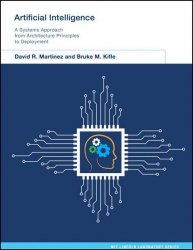 Название: Artificial Intelligence: A Systems Approach from Architecture Principles to Deployment
Название: Artificial Intelligence: A Systems Approach from Architecture Principles to DeploymentАвтор: David R. Martinez, Bruke M. Kifle
Издательство: The MIT Press
Год: 2024
Страниц: 577
Язык: английский
Формат: pdf
Размер: 21.9 MB
The first text to take a systems engineering approach to Artificial Intelligence (AI), from architecture principles to the development and deployment of AI capabilities.
Most books on Artificial Intelligence (AI) focus on a single functional building block, such as Machine Learning or human-machine teaming. Artificial Intelligence takes a more holistic approach, addressing AI from the view of systems engineering. The book centers on the people-process-technology triad that is critical to successful development of AI products and services. Development starts with an AI design, based on the AI system architecture, and culminates with successful deployment of the AI capabilities. Directed toward AI developers and operational users, this accessibly written volume of the MIT Lincoln Laboratory Series can also serve as a text for undergraduate seniors and graduate-level students and as a reference book.
ML—one of today’s most rapidly growing technical fields—is a branch of Artificial Intelligence (AI) focused on employing data and algorithms to extract knowledge and insights without explicit instructions. At its core, ML is all about designing algorithms and models that can learn from data without being explicitly programmed. It is used to recognize patterns, make classifications or predictions, and even learn to perform tasks once thought to be exclusive to human intelligence, such as language and image understanding and generation. These outputs ultimately enable human-machine teams to derive insights used for decision-making in domains such as healthcare, law enforcement, manufacturing, education, and financial services. Over the past decade, advances in the field of deep learning—a technique that uses artificial neural networks (ANNs) to learn from large volumes of data by mimicking the way that the human brain functions—have most notably led to breakthroughs in computer vision, speech recognition, and natural-language processing (NLP).
We begin by exploring the three broad classes of ML—unsupervised learning, supervised learning, and reinforcement learning. We review each of these in more detail, highlighting the motivations for each approach and potential use cases. After introducing these three classes of ML, we discuss a set of common measures of performance for evaluating ML models, such as precision, recall, and area under the curve (AUC). With a foundation of classical ML techniques and ML evaluation metrics, we discuss Deep Learning, which has been the primary technique used in the past decade for achieving unprecedented results.
Key features:
In-depth look at modern computing technologies
Systems engineering description and means to successfully undertake an AI product or service development through deployment
Existing methods for applying machine learning operations (MLOps)
AI system architecture including a description of each of the AI pipeline building blocks
Challenges and approaches to attend to responsible AI in practice
Скачать Artificial Intelligence: A Systems Approach from Architecture Principles to Deployment